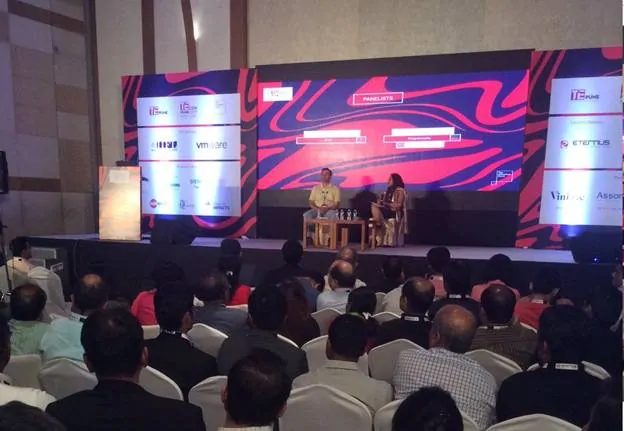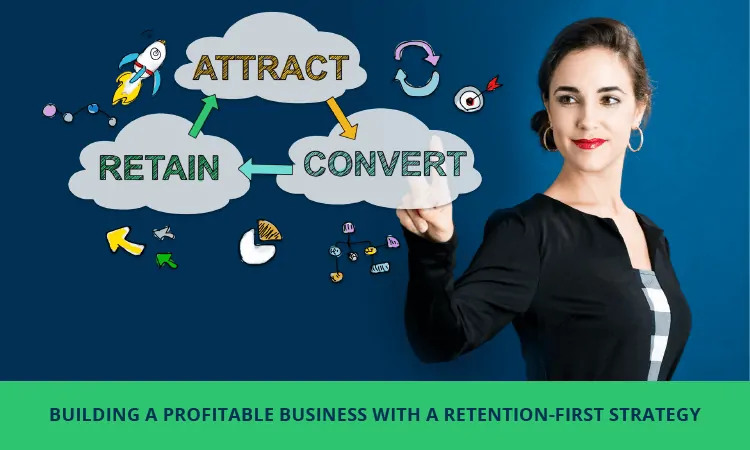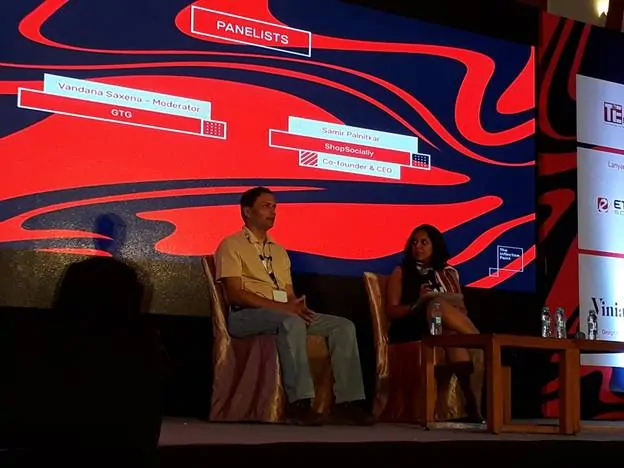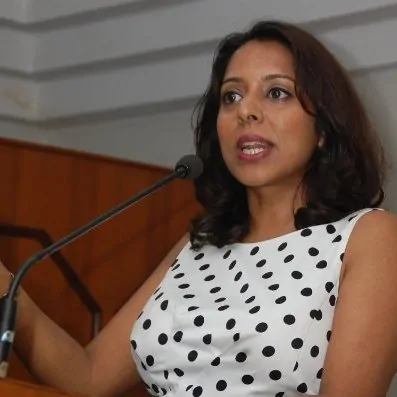Building a Profitable Business with a Retention-first Strategy
Samir Palnitkar, Founder of Zinrelo, was invited by TiECon Pune 2017 to deliver a Q&A session on building businesses with a retention-first strategy. Vandana Saxena Poria, Co-Chair at TiECon Pune 2017 and the founder of GetThroughGuides.com was the moderator for this Q&A session conducted on Saturday, April 15, 2017 from 2.45 pm to 3.30 pm. The session description read as follows:
“Almost a 1,000 startups in India failed in 2016. Companies like Peppertap, TinyOwl and Stayzilla raised millions of dollars, grew rapidly and then suddenly shut shop. How to avoid this? A company cannot achieve success only with a mad rush to acquire new customers. Customer retention is a must to build a profitable business. This session will focus on how both B2C and B2B businesses can incorporate customer retention, loyalty and engagement in their company mantra. Slower but saner growth with a focus on growing revenues from existing customers is a wise and profitable strategy.”
The Q & A excerpts for this session are included below.
Vandana: Can you talk about your experience that made you curious about customer retention?
Samir: Customer retention is a key strategy for both B2B and B2C businesses. My first realization of customer retention was when I founded Obongo, a single sign-on company, founded in 1999 and later acquired by America Online. We realized the need to engage customers repeatedly with our service. We devised strategies to bring the customers back again and again. While acquiring new customers was important, making sure that we did not lose existing customers was a must.
Vandana: Tell us something quirky about your personality that people might not know.
Samir: I love trekking and travel. Last year, I went to Everest Base Camp. That was an amazing experience. I have traveled to over 65 countries. I love to interact with people from different cultures.
Vandana: Coming to retention, why is “retention-first” a sound business strategy?
Samir: Fueled by easy VC money, during 2012 to 2016, a lot of startups in India grew very quickly. But they could not keep customers and lost them to discounts. The positive unit economics was simply not in place.
What killed them was high new customer acquisition costs and not enough repeat purchases, which meant a low customer lifetime value (LTV). They spent so much money on marketing without trying to maximize the LTV of the customer, that they simply could not recover the money. A “retention-first” strategy ensures maximum customer lifetime value and a positive unit economics. That is the basis of a sound business.
Vandana: So, how does a good loyalty strategy improve the unit economics?
Samir: Suppose you are a B2C business and it takes Rs. 1,000 to acquire a new customer. You make Rs. 300 on every order. If the customer makes only one order, then you loseRs. 700 per order. If the customer makes two orders, then you lose Rs. 200 per order.If the customer makes 10 orders, you makeRs. 200 per order.
A good loyalty strategy ensures that the customer does make those 10 orders. Thus the Rs. 1,000 marketing acquisition cost gets amortized over 10 orders instead of 1 or 2, ensuring that you get to positive unit economics.
Vandana: Why are repeat customers as important as new customers?
Samir: New customers are important to growing your user base. Repeat customers are important to grow your revenues. A typical online B2C retailer has only 8% of repeat visitors, but they result in 41% of the revenue. Imagine that a mere 2% increase in repeat visitors will increase your revenue by 10%. Getting more repeat visitors is a leveraged strategy.
Here are a few other statistics. After the 1st purchase, the probability that a customer will buy again is 27%, after 2nd purchase, it jumps to 45% and after third purchase, it is 54%. The third purchase is the tipping point where the customer forms the habit of buying from you.
Customers who buy thrice from you are likely to spend up to 5 times more than new visitors. They are also 3 times more likely to refer their friends.
Vandana: How should founders build retention strategies into the company’s DNA?
Samir: Train your employees to show empathy, care towards customers. Try to go after the customer’s trust, not their money. Trust is more important. Money follows trust.
Put a loyalty rewards program in place before start acquiring lots of customers. Implement a revival strategy for customers who have gone dormant. For example, agree on an inactivity period e.g. 3 months or 6 months. Implement subscription plans that encourage recurring purchases.
Vandana: How should customer retention be implemented for B2C businesses?
Samir: Learn from the airlines miles programs. They have been doing it for years. Customers tend to stick to the same airline because they get lounge access, business class upgrades, priority queues etc.
B2C businesses should implement a loyalty rewards program which gives users points. Points can be redeemed for money off future purchases. B2C businesses should get users “invested” in their currency. Customers are more likely to buy from The B2C business if they have accumulated their “currency”.
Separate users into tiers:
- Low spenders (1-2 purchases)
- Medium Spenders (3-5 purchases per year)
- High Spenders (6+ purchases per year)
Treat the high spenders really special. Birthday greetings, free shipping, accelerated points, call from the CEO etc. Surprise your high spenders by showering them with attention. They will spend more and refer more.
Vandana: How should B2C businesses build customer loyalty into their growth plans?
Samir: Most businesses in India today focus on growth, growth, growth. My recommendation is to intersperse growth and retention strategies. For example, growth, retention, growth, retention, growth, growth, growth. Pause to implement great retention strategies that make your growth count. Otherwise, your business is a leaky bucket, which attracts a lot of new customers but also loses a lot of those customers.
Vandana: How does one set objectives for a good loyalty rewards program?
Samir: There are two milestones in the buying lifecycle. When a customer makes 3 purchases, it is a habit-forming activity. The customer gets into the habit of buying from you. When the customer makes between 6 to 10 purchases, the customer becomes a loyal customer.
Create 3 tiers
- Low spenders (0-2 purchases per year)
- Medium Spenders (3-5 purchases per year) – habit formed
- High Spenders (6+ purchases per year) – loyal customers
Design your loyalty rewards program to get all customers to the highest tier.
Vandana: What are examples of B2C companies with great customer retention strategies?
Samir: Starbucks Rewards is an example of a great rewards program. They award 2 stars for every dollar spent. At 125 stars, customers earn a free drink. This strategy has propelled Starbucks to $19.6 billion in revenue. Habitual coffee drinkers are likely to stick with Starbucks rather than go to other coffee shops to earn the free drinks.
Closer to home in Pune, MedsOnway, a personalized medicine delivery service specializing in recurring orders, that got funded recently is using some innovative retention strategies.
The responsibility of getting the customer to place the first order lies with the marketing and sales team. Second order onwards, the responsibility shifts to the retention and revival team.
MedsOnway trains their customer service team to show care and empathy towards their customers. The customer service team will help not just for medicines but other medical needs as well, even if they do not profit from it. The paradigm is to spend as much time with the customer on phone as possible so that a personal connect can be established. This is contrary to the general belief that customer service calls should be ended as quickly as possible. This strategy has enabled MedsOnway to achieve 90% + customer retention, month over month.
Vandana: This talk about customer service brings to mind Zappos, a shoe company in the US, became a huge success because of its exceptional focus on customer loyalty. It was later bought by Amazon. Can you tell us a little bit about their customer service?
Samir: Most companies customer service spends as little time as possible with the customer. Zappos’ strategy is to spend as much time as possible with the customer.
There is a famous Zappos pizza story of Tony Hsieh, the founder of Zappos, who had a Client meeting. It was 11 pm and the Client was craving for Pizza. All pizza places were closed. Tony suggested that the Client call Zappos customer care. The Client was puzzled because Zappos sold shoes but did call them out of curiosity. Though the Client was not looking to buy shoes, the Zappos Customer Service member found 3 pizza parlors that were open after 11 pm and got pizza delivered to the Client. Zappos earned the Client’s trust, for life. This is a story that is fondly repeated by Tony Hsieh.
This kind of exceptional customer service can create fierce loyalty for a brand. Great loyalty programs can deliver 2.4 times more revenue per existing customer, 80% improvement in repeat sales frequency and 33% increase in average order value.
Vandana: Another term that often pops up when talking about customer loyalty is Net Promoter Score or NPS? What is it? How does it help?
Samir: Net Promoter Score or NPS is an index ranging from -100 to 100.
All customers are asked a question – “On a scale of 0-10, how likely are you to recommend this business to a friend or colleague?” Responses are divided into three categories.
- Detractors – 0-6
- Passive – 7-8
- Promoters – 9-10
Subtract percentage of customers who are detractors from the percentage of customers who are promoters. That is the net promoter score. The average NPS across 400 companies across 28 industries surveyed in 2003 was 16, rather low. If NPS is negative, it is time to dig deeper into the business fundamentals. If NPS is positive, it is worthwhile to see how to improve it. Economic benefits are enormous.
Vandana: Are customer retention programs applicable to B2B businesses?
Samir: Yes, absolutely. Though the dynamics of a B2B business are different from a B2C business, the principles of customer satisfaction are the same.
Getting more revenues from existing customers is far easier than getting new customers. There are a few things that B2B businesses must do:
- An account management function is a must. The Account Manager must meet with the customer regularly to understand the current status and future needs.
- Measuring NPS through quarterly or yearly surveys is a must. This helps the business re-align.
- Customer advisory boards are recommended for high-spending customers. Customer advisory boards meet at least once a year. This converts customers into stake-holders.
Vandana: Thank you very much for your insights regarding building retention-first businesses. The audience will benefit tremendously from it.
About the Author
Vandana Saxena Poria OBE is an award-winning, eminent high profile visionary, who specializes in talent analytics and then creates revolutionary learning experiences to grow skills in the workplace. Vandana is the founder of Get Through Guides, Co-founder Cavantics and is a Non – Executive Director on the Indian Board of UK India Business Council.





